|
|
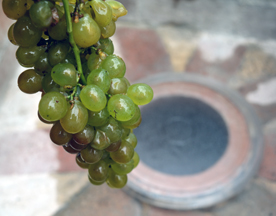 Kathy and I acquired some Rkatsiteli grapes yesterday from our friends at Bluemont Vineyards in Bluemont, Virginia. Arriving home, we began to process the grapes and prepare the qvevri. Qvevri winemaking is an ancient winemaking method and the only winemaking process on the UNESCO list of Intangible Cultural Heritage. Kathy and I acquired some Rkatsiteli grapes yesterday from our friends at Bluemont Vineyards in Bluemont, Virginia. Arriving home, we began to process the grapes and prepare the qvevri. Qvevri winemaking is an ancient winemaking method and the only winemaking process on the UNESCO list of Intangible Cultural Heritage.
Cleaning the Qvevri
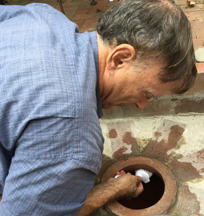 I had learned to clean a qvevri while at Twins Wine Celler in Napareuli in the Kakheti wine region of the country Georgia. The basic process is to pour clean water into the qvevri, and using a brush, scrub the sides. Remove the water and observe the color. Repeat the process until the water is clear once removed. The first time I added water to our qvevri and scrubbed the interior wall of the qvevri, the water was cloudy and opaque. By the fourth bucket of clean water the water had just a touch of cloudiness and was translucent. After the fifth cleaning the water was clear. This paralleled the process that was done to the qvevri we made wine in at Twins Wine Celler. I had learned to clean a qvevri while at Twins Wine Celler in Napareuli in the Kakheti wine region of the country Georgia. The basic process is to pour clean water into the qvevri, and using a brush, scrub the sides. Remove the water and observe the color. Repeat the process until the water is clear once removed. The first time I added water to our qvevri and scrubbed the interior wall of the qvevri, the water was cloudy and opaque. By the fourth bucket of clean water the water had just a touch of cloudiness and was translucent. After the fifth cleaning the water was clear. This paralleled the process that was done to the qvevri we made wine in at Twins Wine Celler.
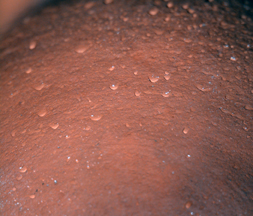 Water droplets beading up on the wall of the qvevri To sanitize the qvevri, I sprayed potassium metabisulfite on the interior and soaked up the extra liquid that collected at the qvevri’s base. I did not add another coating of beeswax to the interior of the qvevri. Asking Georgian winemakers how often they coat the interior of the qvevri with beeswax produced a plethora of answers. The answers ranged from reciting yearly to once every several hundred years. I prefer the later response. I noticed while cleaning, that water beaded up on the sides of the qvevri like water beads on a recently waxed car. The beeswax I applied before burying the qvevri last year is doing its job and does not need to be reapplied
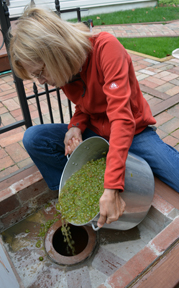 Preparing the Grapes Preparing the Grapes
Since our qvevri is small, just 23 liters, we were not working with a lot of grapes. We destemmed by hand and gently crushed the grapes before adding to the qvevri. This did take us hours and caused us to wonder about how much faster it would be with a destemmer/crusher. On the other hand, we would only use the machine once a year. Just like last year we sorted the grapes as we pulled them off their jacks. Unlike last year I collected some of the stems to put into the qvevri with the grapes.
While in Georgia, we were told that “Rkatsiteli” means red stem. Some of the stems had begun to turn red and those were the ones I added to the qvevri. In total, the stems only accounted for a small percentage of the must. Kathy and I used up all the grapes and finally had the qvevri filled to within two inches of the surface. We did add yeast, Lalvin D21. In Georgia, the winemakers use the natural yeast on the grapes. They have been making wine there for 8,000 years and the yeasts have figured things out. I did not want to risk using natural yeast so I went with a commercial yeast. After pitching the yeast, I placed a lid on the qvevri that has an airlock in the center. It is fall after all and if I let the qvevri open things would fall into it.
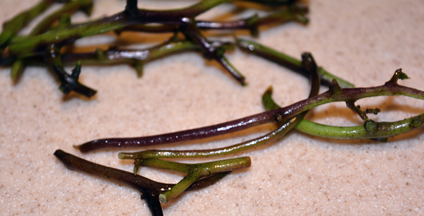 “Rkatsiteli” means red stem. I added more than pictured to the must in the qvevri. We are now awaiting for the fermentation and daily punchdowns.
Cheers,
Terry
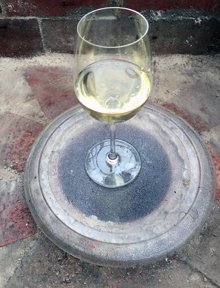 My first qvevri wine is a 2014 Muscat. Fermented and aged in qvevri for six months. My first qvevri wine made in Maryland is not what I expected; however, it definitely was worth the wait. Besides the color, the wine is great. I did not expect the light yellow color. After all, maceration on the skins for six months should have added some color to the Muscat wine. There was little if any color extraction.
The wine did have its merits. The intense orange aroma and taste of the Muscat was readily available. The velvety mouthfeel was surprising and there was a touch of heat on the finish. There was a long orange aftertaste lasting a few minutes. Otherwise, the wine showcased the Muscat grape perfectly.
I brought the 23 liter qvevri from the country Georgia in 2014. After coating the inside with beeswax to seal the pours, I coated the outside with a lime based mortar. The qvevri was then buried underground. I was in Catalonia, Spain on a winery tour during the critical time to purchase grapes. It wasn’t until the middle of October that I was able to get grapes from a supplier. They looked like the leftovers. Kathy and I sorted and destined the grapes by hand. We chose only the best ones for the qvevri. Fermentation was active by October 18th. For the remainder of October, I punched down the grapes. The qvevri was sealed in November and covered with sand. Throughout the winter months the wine aged with the skins, seeds and lees.
Opening the qvevri in the middle of April, I discovered that the sediment did not settle at the qvevri’s bottom. Instead the wine seemed to be in a constant vortex. I racked the wine into a carboy where the particles did settle. It was bottled in late June.
You learn from the past. This year I hope to acquire grapes by early September and crush the grapes prior to putting them into the qvevri. I also plan to add stems this time, omitting them last autumn. I have not decided on the variety, I will have to see what is available.
One of my major concerns last year was oxidation. The wine is not oxidised. I did burn some sulphur over the wine in the qvevri before sealing it last November. This ancient winemaking method worked well. If one wants to truly make a natural wine that lets the grape express itself, qvevri winemaking is the way to go.
Cheers,
Terry
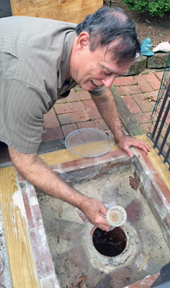 This photo was taken of the wine and the qvevri. The wine spent the last two weeks in a carboy settling. Two weeks ago Kathy and I racked our wine out of our buried qvevri. The wine was cloudy and the skins had not dropped from the surface. My theory was that the wine was in a constant state of motion while in the qvevri. A day after racking into a three-gallon glass carboy, there was a layer of sediment on the bottom. After two weeks, I decided to rack the wine into a new carboy. The sediment reminded me of dead yeast cells. There were also some very small specks of skin from the grapes. Since I had an extra quart of wine, I was able to rack and full three gallons and had some left over for tasting.
This qvevri wine was made with Muscat grapes sourced from Lodi, California. It was a cloudy yellow color. The aroma was very floral with some orange blossoms. Orange was predominant on the taste. The wine was full bodied, one of the first signs that it spent time (six months) on the skins. Other wines that I have had made with Muscat grapes were lighter bodied than this qvevri wine. There was a faint trace of tannins. The wine had a long aftertaste and a bit of alcohol heat. It has 14% alcohol.
If I were to make this wine again, I would put some stems in the qvevri. I have been told that the stems will help with settling within the qvevri as well as add some tannins to the wine. I enjoy tannins in a wine. My next qvevri wine will be made with whatever grapes I can source locally. I am considering Viognier, but would also investigate if I can get some Rkatsiteli. There is a grower in Virginia growing Rkatsiteli. My reaction to our first qvevri wine is that it is OK, but can be improved. Looking forward to this year’s harvest and some locally sourced grapes.
Cheers,
Terry
On Sunday we opened the qvevri. I sealed the top of the qvevri last October 31st. The wine had been in the qvevri for 5 ½ months. I expected to see the clear wine at the top while the lees, seeds and skins in layers at the bottom. This is not what happened.
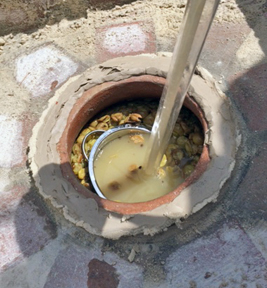 Cloudy wine and skins at the top of the qvevri while racking to a carboy. After moving three cubic feet of sand off the qvevri, we removed the top. Grape skins were at the surface. They did not fall to the bottom of the qvevri. Furthermore the wine was very cloudy, not clear. I racked the wine into a three gallon carboy. Two days later, the wine is clearing as particles are falling to the bottom. Why didn’t this happen in the qvevri. I have my theories.
One thought is that the egg-shape of the qvevri caused the wine to be in constant motion. If you took a spoonful of dirt and added it to a glass of water and gently stirred it, particles of the dirt would disperse through the water. As long as there was motion there would not be much settlement. Stop the stirring and the particles will fall to the bottom. This seems to be what is happening in my qvevri. While in the qvevri, the motion kept things stirred up. Now that the wine is in a carboy, particles are beginning to fall to the bottom.
Another thought is that my qvevri is only 23 liters, not several hundred or even one to three thousand liters in size. I have had many winemakers tell me over the past several years that making wine in small vessels is much more difficult than making it in larger vessels. I do not know if the mass of skins was heavy enough to fall to the bottom. Iago Bitarishvili, winemaker at Iago’s Wine in Chardakhi, Kartli, Georgia, concurred with the difficulty of making wine in small vessels. Because of the size of the vessel, there is a tendency not to add stems. Stems help with the filtering of the wine, but they take up space. I did not add stems to the qvevri back in October. This autumn, I will sacrifice wine and add some stems.
In a take on “misery enjoys company,” Giorgi Barisashvili of George Barisashvili Wine Cellar in Mtskheta, Kartli, Georgia commented that the grape skins remained at the top of the qvevri. This happened to him and some other Georgian winemakers this year. He has a theory that bacteria was causing a fermentation. With the weather finally warming, it is possible that malolactic fermentation took place and helped keep the skins at the top.
Kathy and I did taste the wine. My initial reaction was that the wine was floral and had a yeasty taste. The wine was made from Muscat grapes. The muscat grape profile kicked in on the aftertaste and remained for several minutes.
I will continue to research what happened. In the meantime, I will add steps to the winemaking protocol. I plan to leave the wine in a carboy until it clears up quite a bit. It has been getting clearer each day. Than I’ll rack to a clean carboy and filter before bottling. I should end up with 12 to 15 bottles. I already have additional thoughts about what I hope to do differently this year. I would like to make the wine in the qvevri in September rather than October. I will also add some stems and may do a better job of crushing the grapes before adding to the qvevri.
Cheers,
Terry
On the second day of the Craft Beverages Unlimited trade show and conference, Kathy and I attended the afternoon forum on Post Modern Winemaking. The format of this session was different than sessions we attended in previous Wineries Unlimited shows. The room was arranged in a semi-circle of tables, with eight glasses at each setting. A microphone was between every three or four settings. The moderators, Dr. Bruce Zoecklein, Enology Professor Emeritus, Virginia Tech and Clark Smith, author of “Postmodern Winemaking” sat in the middle and directed the forum.
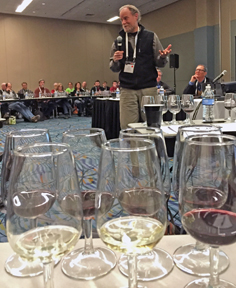 Jim Law from Linden Vineyards and Winery discusses terror winemaking. During this four-hour session, several topics were covered, wines were tasted and winemakers commented about the wines. Then there were questions from the attendees. Jim Law of Linden Vineyards and Winery began the forum with terroir winemaking. We then tasted and comment about several of his wines that showed unique characteristics based on terroir. Other topics that were discussed and wines tasted included:
• Reduction management
• Enological oxygen, O2 appetite
• Minerality
• Sulfite-free winemaking
The topic I was looking forward to was Clay Jar Wines. Clark Smith showed slides of photos of qvevris from the country Georgia. He talked about making wine in these qvevris buried underground. He asked me to say a few words about qvevris. I talked about preparing the qvevri for burial underground and the need to heat the qvevri to 160º F and coat the inside with beeswax that is heated to 220º F. I then spoke about making a grid of galvanized wire on the outside of the qvevri and adding a coat of lime based mortar to the outside of the qvevri. There was only one “clay jar wine” for tasting. This was a qvevri-made SINCE 1011 Rkatsiteli. SINCE 1011 is Alaverdi Monastery’s brand and refers to wines made at the monastery since the year 1011. The Rkatsiteli spent one and a half years in qvevri. The amber colored wine had an aroma and taste of dried fruit. The fruity finish had bold tannins.
Clark mentioned that the wine was not oxidized. Many conclude that qvevri white wines are oxidized based on the wine’s color. However spending so much time on the seeds, skins and stems will color many white wines a gold to amber. I did not notice any sherry-like or Jura-like aromas or flavors. The wine was complex and one needs to take in account the influence of seeds, skins and stems.
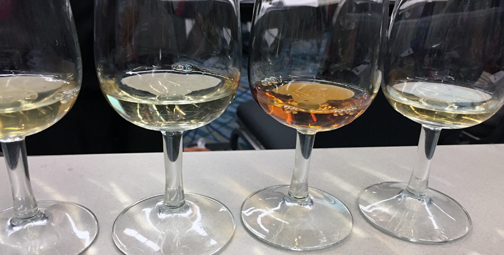 The 3rd wine from the left is the qvevri wine Since 1011 Rkatsiteli by Alaverdi Monastery in the country Georgia. The forum set-up was interesting. The four-hour time frame was a bit long. I like the idea of talking about concepts and having wines to taste that blend with the concept. I wish we would have had more clay jar wines to taste. I would have liked to taste a white wine made in clay vessels that are not buried underground and compare to those buried underground. It would also be interesting to compare different wines that spend different amounts of time on their skins, seeds and stems.
Cheers,
Terry
 Hillbilly Stills had a still set up at the trade show. many distilleries “have copper.” Craft Beverages Unlimited added a new track to their trade show and conference in 2015. The distillery track was led by Mike Rasmussen from Painted Stave Distillery and Bill Owens from the American Distilling Institute. After introducing themselves Mike asked the attendees to tell about why they were here. There were several people that were starting or just opened a distillery. The largest group of attendees were winemakers that were looking to add distilling to what they were crafting.
Bill began the presentation by showing numerous photos of stills. He mentioned that purchasing stills is a long process. There is a waiting list of stills needed throughout the world. Some creative distillers build their own stills. Bill made a point that home-made still are usually small and it takes a lot of time to distill a few gallons. He suggests getting larger stills in order to distill larger quantities. The slides, of different types of stills, showed the wine variety of both commercial-made and home-made stills. Bill stated that if your distillery is large enough, you can entertain visitors. He poked fun at the wine and beer tourism industry. “At wineries you see stainless still tanks and barrels. At breweries, nobody understands what is happening. But at distilleries, we have copper.”
Bill talked about the desire that consumers have for visiting a farm distillery. Consumers like that grains and fruit are farmed on the land and eventually distilled. Bill talked about some of the differences between winemakers, brewers and distillers. “If you make a mistake in the distilling industry, you can re-distill. If you make a mistake in the beer or wine industry, you are dead.”
Mike Rasmussen from Painted Stave Distillery in Smyrna, Delaware spoke about his experience about distilling. Mike stated that it was illegal to have a distillery in Delaware. Mike crafted legislation to change the Delaware law to allow craft distilling. A few years later, he started Painted Stave Distillery. There was an old theater building in Smyrna that was abandoned. He was able to convert the building into a tasting room and production facility. The distillery produces Vodka, Gin and Whiskey. They also make a little grappa. The distillery focuses on local products. For example, local farms grow the botanicals used in the production of gin.
Mike runs most of his products through the still twice. He likes to run an item through the still as soon as fermentation is completed. Mike talked about a stripping run and the finishing run. heads and tails are removed during the second distilling run. He also removes some of the first heads collected during the first distilling run.
Miked spoke about creating partnerships with wineries and breweries. His distillery works with Harvest Ridge Winery for fruit, wine, pomace and barrels. A partnership with breweries includes sending whiskey barrels to the breweries. He also sources grain from breweries. Perhaps the most important partnership is working with tourism organizations on both state and county levels.
Regarding sales and marketing, Mike was amazed at how important the tasting room is. About 70% of his sales are from the tasting room, where visitors can taste the spirits straight or in a cocktail. Many of his guests have visited wineries or breweries, but visiting distilleries was new to them. Painted Stave Distillery offers an in-depth tour of the distillery where they explain the process.
Mike talked about different distilled products. Vodka is a distilled spirit at or above 95% alcohol (190 proof), and if bottled it is not less than 40% alcohol (80 proof). Vodka are distilled spirits that have been run through charcoal or other materiel or filtered. Gin is a spirit with a flavor derived from juniper berries and bottled an not less that 40% alcohol (80 proof). Brandy is distilled from fermented juice, mash or wine from its residue at less than 95% alcohol (190 proof). It has to be bottled at not less than 40% alcohol (80 proof). Grappa is a brandy. Whiskey is a spirit distilled from fermented mash of grain at less than 95% alcohol. Many types include Bourbon, Rye, Malt, Scotch, Irish, Canadian and others.
After the session about distilling, we visited the trade show where we had lunch, then boarded buses to visit two distilleries in Richmond. For the first time track at Craft Beverages Unlimited, the group enjoyed the visits to the two distilleries and discussions with the distillers. After the field trip we returned to the trade show and samples some distilled spirits.
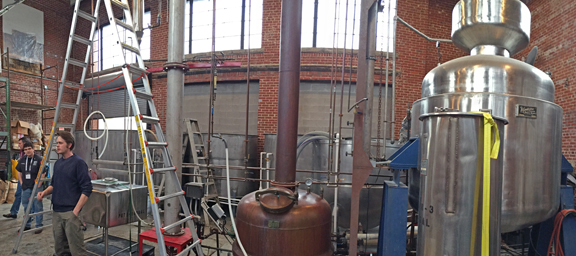 We visited James River Distillery in Richmond, Virginia. Dwight Chew, head distiller, talked about the modifications he made to the distillery and the process he uses. Cheers,
Terry
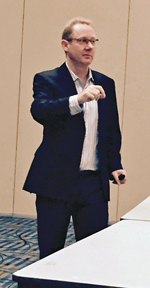 Ron Cates talks about the power of digital marketing. Ron Cates from Constant Contact delivered the general session presentation of the second day of Craft Beverages Unlimited. Have the wine, beer and spirits utilized the power of digital marketing? The focus of Ron’s talk was on email and social media. Ron started with email, a marketing tool that he sees is the original form of social media. He spoke about the myth that email is dead. Ron pointed out that you need an email account to register on Facebook. He asked the audience how many have already tweeted today or posted on Facebook. Very few raised their hands. Ron then asked how many of the attendees checked their email today. Most raised their hands.
Email offers the highest return on investment over search, display and social. There are things that consumers expect with email. One is that email is to look professional. Do not make your entire email based on images because many email programs automatically block images. There should be a contrast between text and the background. Also consider sending different messages to different groups as opposed to the same message to everyone on your email list. The choice of fonts and size should be based on your market. The ideal subject line is short. Try to keep it in the low 30s characters. It should be read in two seconds and have two words. Long subject lines may be cut by the email client. People tend to take action on subject lines without reading the email. Best days in the United States to send email is Tuesday, Wednesday and Thursday at 10:30 am. If you are sending emails to people in different time zones, create different lists and send email to each list when it is 10:30 am in their time zone.
Ron called social media the center of a party on steroids. Sharing content is very important. Social media influences decisions. Ron presented a slide that showed 74% of people make purchase decisions by relying on social networks. You do not have to be perfect when using social networks because using social is forgiving. There are many niche sites that you can belong to.
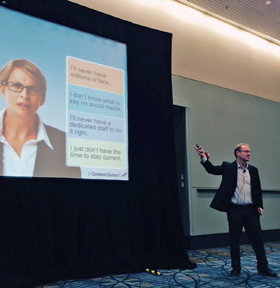 What can wineries, distilleries and breweries gain from social media? They can gain a presence. It does not take unheard of hours to send content on social media platforms. Use Facebook between three and ten times a week. Share content rather than trying to sell something. To engage on Twitter, send at least five tweets a day. There is no maximum number of tweets. Share content and retweet. LinkedIn is a professional network. Share content at least two times a week. There are numerous craft beverages groups that you can belong to on LinkedIn and post content or participate in discussions. Pinterest is an image social media platform. Post several pictures a day. What can wineries, distilleries and breweries gain from social media? They can gain a presence. It does not take unheard of hours to send content on social media platforms. Use Facebook between three and ten times a week. Share content rather than trying to sell something. To engage on Twitter, send at least five tweets a day. There is no maximum number of tweets. Share content and retweet. LinkedIn is a professional network. Share content at least two times a week. There are numerous craft beverages groups that you can belong to on LinkedIn and post content or participate in discussions. Pinterest is an image social media platform. Post several pictures a day.
Craft beverage providers should examine their marketing strategies using email and social media. Perhaps there are platforms that they may want to explore. In my case, I was mostly a Twitter user until I started meeting winemakers and wine enthusiasts from the country Georgia. In Georgia, the main social platform is Facebook. I have since used Facebook more often. I post to Twitter and Facebook almost daily usually within the guidelines offered by Ron.
Cheers,
Terry
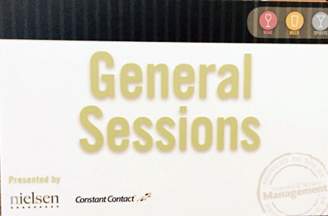 The opening general session of the 2015 Craft Beverages Unlimited, formally Wineries Unlimited, focused on trends in beer, wine and spirits. The speaker, Danelle Kosmal from Nielsen’s Beverage Alcohol Practice presented statistics gather by Nielsen. The opening general session of the 2015 Craft Beverages Unlimited, formally Wineries Unlimited, focused on trends in beer, wine and spirits. The speaker, Danelle Kosmal from Nielsen’s Beverage Alcohol Practice presented statistics gather by Nielsen.
Danelle opened her talk with the number of new alcohol beverages that Nielsen tracked in 2014. The astonishing number of new products was 10,441 with new items including 4,622 new wine items. Danelle then spoke about consumer confidence in the US market. Today there are 65% of respondents that feel we are still in a recession. Even though there is presently a lackluster growth for all sales, alcohol sales are doing well. Danelle mentioned much of the off-premise sales data for beer, wine and spirits.
Tracked sales across beer, wine and spirits during 2014 include $103 billion in sales for beer, $77 billion in sales for spirits and $31 billion in sales for wine.
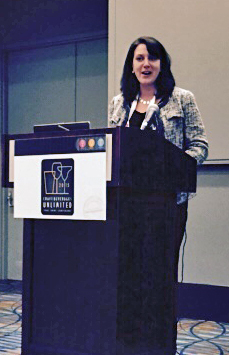 Danelle Kosmal from Nielsen’s Beverage Alcohol Practice presented statistics gather by Nielsen. For beer, the drivers of growth for craft beers were hoppy styles of beer. Growth was also tracked for the distribution of beer including more and new products. Another craft beer growth was seen with offering variety packs and pick-6. Growth can also be attributed to packaging in cans although bottles still leads the craft beer packaging. People like to purchase craft beer because of different styles and tastes. Consumers also like seasonal varieties. Variety packs are popular for parties and holidays. The strongest market for craft beers is in Portland, Oregon followed by other west coast markets. Lime continues to be the top flavor for beer.
Cider is a very small category, but showed a 67% growth in 2014. Consumers see ciders as a bridge between beer and wine.
Wine
Higher price wines have about 25% of the sales, but account for 50% of the value. While lower price tiers have 75% of the sales and account for 50% of the value. Red wines are still leading in wine sales with about 46% of the sales, although white wines are only trailing at 44% of the volume. Prosecco leads the growth in sparkling wine sales. As far as varietal wines, Chardonnay leads with 19.4% of the volume while Cabernet Sauvignon has 13.3% of the sales volume. Wine innovation is led by red blends.
Red blends were looked at more closely. Consumers resonate with red blends seeing them as more interesting than single variety wines. This interest in variety is seen across all alcohol beverages. Red blends seem to be purchased in addition to single varietal wines. Most wine purchases are still from the west coast.
Spirits
Whiskey still leads the sales volume for spirits. Bourbon, Irish and Rye are showing double digit increase in sales. More females and Hispanics are leading the growth. One of the growth drivers is flavored whiskeys. Although the segment is small the value of the sales is high.
Danelle spoke about trends in the alcohol beverage industry. Off-premise sales lead on-premise sales. A trend is purchasing alcohol in grocery stores that also have restaurants. E-commerce and alcohol delivery apps are beginning to be trends. The idea of drink local is also trending in beer, wine and spirits. Beer had 44% of respondents that see buying local as important while 33% for wine and 22% for spirits. There is a crossover of consumers that purchase wine and beer or spirits.
The consumer is showing different purchasing behaviors. The age group 21 – 36 is drinking less beer and more wine and spirits. Even though beer purchases is slightly reduced for this age group, craft beers are very popular for this group. In major US cities, roughly half of the 21 – 36 age group are Hispanics. High end growth for wine is being driven by the older aged groups.
Variety and trying something new is the trend in the alcohol beverage industry.
Cheers
Terry
For decades Wineries Unlimited has been the premiere wine trade show in the Eastern United States. Several years ago the trade show moved from South Eastern, Pennsylvania to its new home in Richmond, Virginia. We attended the first show in Richmond in 2011 and attended again in 2012. Since that 2012 show, Wineries Unlimited has expanded to include beer. This years marks another expansion, to include distilled spirits. The name also has changed and now the trade show is know as Craft Beverages Unlimited.
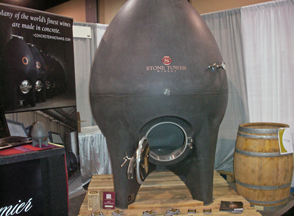 The two day conference and trade show takes place on March 4th and 5th at the Greater Richmond Convention Center. Each morning begins early with a general session from 8:00 am until 9:00 am. On Wednesday the topic of this general session is “What’s Trending in Beverage Alcohol” and Thursday’s session is titled “The Power of Digital Marketing.” Each day at 10:00 am the trade show opens. Over 100 businesses will have tables set up for attendees to visit and chat about their products or services. On Wednesday the trade show closes at 6:00 pm and on Thursday the trade show closes at 2:00 pm. The two day conference and trade show takes place on March 4th and 5th at the Greater Richmond Convention Center. Each morning begins early with a general session from 8:00 am until 9:00 am. On Wednesday the topic of this general session is “What’s Trending in Beverage Alcohol” and Thursday’s session is titled “The Power of Digital Marketing.” Each day at 10:00 am the trade show opens. Over 100 businesses will have tables set up for attendees to visit and chat about their products or services. On Wednesday the trade show closes at 6:00 pm and on Thursday the trade show closes at 2:00 pm.
During the other hours of the day there are concurrent sessions running. On both days from 9:00 am to 12:00 noon, there are sessions covering marketing and business. At the same time both days there are sessions covering beer. From 10:00 am until 4:00 pm the first day there is a session on distilling. Kathy and I are going to attend this session because it is new and we are expanding our website to include distilleries that we have visited over the years. The distilling session also has a field trip to a local distillery. As a former teacher, I always enjoyed field trips. The wine sessions are from 2:00 pm until 6:00 pm each day.
Late afternoon/evening events take place the first day of the conference. There is Spiegelau Beer Tasting on Wednesday, March 4th from 5:00 pm – 6:00 pm. From 6:30 pm to 8:30 pm there is a networking party at the Capital Ale House that will feature food and beverage parring. The Capital Ale House is about 0.6 mile from the convention center. It is only half that distance from our hotel.
We are looking forward to attending this years Craft Beverage Unlimited and hope to learn much about distilling and wine production. I also hope to track down one of the wine speakers who will talk about “four white wine methodologies, clay jar wines.” This topic piqued my curiosity since I have a qvevri with a white wine in it. The qvevri is buried under ground and the white wine is on its chacha. I’m planning to open the qvevri at the end of March or beginning of April unless this bitter cold continues and delays spring. Next week Kathy and I will cover Craft Beverages Unlimited with daily blog posts.
Cheers,
Terry
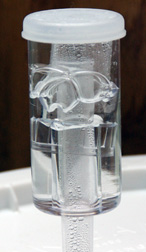 My wife, Kathy, gave me a wine kit as a Christmas present in 2007. We have been writing about wineries for a year and made the decision that if we were going to write about wine, we should make wine. The kit remained in the box for six months until I gained the courage to plunge forward and make the wine. The wine turned out being the worst wines we have made in seven years. We had no guidance other than YouTube videos. If I knew then what I know now about winemaking my protocol would be different then the directions. My wife, Kathy, gave me a wine kit as a Christmas present in 2007. We have been writing about wineries for a year and made the decision that if we were going to write about wine, we should make wine. The kit remained in the box for six months until I gained the courage to plunge forward and make the wine. The wine turned out being the worst wines we have made in seven years. We had no guidance other than YouTube videos. If I knew then what I know now about winemaking my protocol would be different then the directions.
In a “history repeating itself moment,” we gave our daughter and son-in-law a wine kit as a Christmas present in 2013. It set unmade for over a year. We visited them over the 2014 holidays and finally they began. Now I see the value of some level of mentoring in early stages of winemaking. We talked them through each step and explained why they were doing what they were doing. I’ve received a few telephone calls and several photo of where they were since starting the process. Along the way I was able to give a bit of advice. This seemed to really calm them down. I’m sure they will continue to make wine in the future.
Lending a helping hand is a wine industry standard. Over the years I talked to winemakers around the world and sought advice. One situation is topping off wine. What do you do to help avoid oxidation once you use some of the wine to top off? I am referring to very small batches such as a gallon of wine not the topping off wine in variable capacity tanks. Winemakers had many ideas. The obvious was to put the remaining wine into a smaller bottle. Another winemaker suggested placing sanitized marbles in the original bottle until the volume rose. I decided to go with different sized bottles. I also received some interesting advice on what to do with the first wine we made. To improve the wine, one winemaker suggested that I pour about an inch of port in the bottom of a decanter and then pour in the wine. Another winemaker asked, “Why would you want to ruin the port?”
In making my first qvevri wine in Maryland, I sought advice from winemakers in the country Georgia. I received specific guidance on what to do to coat the inside of the qvevri with beeswax. Afterwards I received advice on what to do to protect the qvevri and its wine from the extreme cold that we are having in Central Maryland. The qvevri is buried underground, but I would like to keep it from freezing.
Winemakers are a great source of advice, and we have always experience them willing to share it. Going through the process of making wine for the first time can be daunting and a mentor can certainly ease the way. Have you mentored new winemakers?
Cheers,
Terry
|
|
 Kathy and I acquired some Rkatsiteli grapes yesterday from our friends at Bluemont Vineyards in Bluemont, Virginia. Arriving home, we began to process the grapes and prepare the qvevri. Qvevri winemaking is an ancient winemaking method and the only winemaking process on the UNESCO list of Intangible Cultural Heritage.
Kathy and I acquired some Rkatsiteli grapes yesterday from our friends at Bluemont Vineyards in Bluemont, Virginia. Arriving home, we began to process the grapes and prepare the qvevri. Qvevri winemaking is an ancient winemaking method and the only winemaking process on the UNESCO list of Intangible Cultural Heritage. I had learned to clean a qvevri while at Twins Wine Celler in Napareuli in the Kakheti wine region of the country Georgia. The basic process is to pour clean water into the qvevri, and using a brush, scrub the sides. Remove the water and observe the color. Repeat the process until the water is clear once removed. The first time I added water to our qvevri and scrubbed the interior wall of the qvevri, the water was cloudy and opaque. By the fourth bucket of clean water the water had just a touch of cloudiness and was translucent. After the fifth cleaning the water was clear. This paralleled the process that was done to the qvevri we made wine in at Twins Wine Celler.
I had learned to clean a qvevri while at Twins Wine Celler in Napareuli in the Kakheti wine region of the country Georgia. The basic process is to pour clean water into the qvevri, and using a brush, scrub the sides. Remove the water and observe the color. Repeat the process until the water is clear once removed. The first time I added water to our qvevri and scrubbed the interior wall of the qvevri, the water was cloudy and opaque. By the fourth bucket of clean water the water had just a touch of cloudiness and was translucent. After the fifth cleaning the water was clear. This paralleled the process that was done to the qvevri we made wine in at Twins Wine Celler.

















